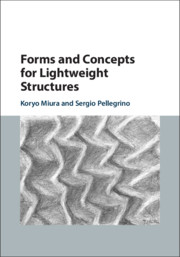Refine search
Actions for selected content:
2002 results in Engineering design, kinematics, and robotics
5 - Shell Structures
-
- Book:
- Forms and Concepts for Lightweight Structures
- Published online:
- 09 March 2020
- Print publication:
- 26 March 2020, pp 128-157
-
- Chapter
- Export citation
Appendix A - Geometric Foundations
-
- Book:
- Forms and Concepts for Lightweight Structures
- Published online:
- 09 March 2020
- Print publication:
- 26 March 2020, pp 337-365
-
- Chapter
- Export citation
8 - Concepts for Deployable Structures
-
- Book:
- Forms and Concepts for Lightweight Structures
- Published online:
- 09 March 2020
- Print publication:
- 26 March 2020, pp 224-279
-
- Chapter
- Export citation
Index
-
- Book:
- Forms and Concepts for Lightweight Structures
- Published online:
- 09 March 2020
- Print publication:
- 26 March 2020, pp 397-404
-
- Chapter
- Export citation
9 - Applications of Deployable Structures
-
- Book:
- Forms and Concepts for Lightweight Structures
- Published online:
- 09 March 2020
- Print publication:
- 26 March 2020, pp 280-305
-
- Chapter
- Export citation

Forms and Concepts for Lightweight Structures
-
- Published online:
- 09 March 2020
- Print publication:
- 26 March 2020
Preface
-
- Book:
- Dynamics of Multibody Systems
- Published online:
- 14 September 2020
- Print publication:
- 05 March 2020, pp xi-xiv
-
- Chapter
- Export citation
1 - Introduction
-
- Book:
- Dynamics of Multibody Systems
- Published online:
- 14 September 2020
- Print publication:
- 05 March 2020, pp 1-27
-
- Chapter
- Export citation
5 - Floating Frame of Reference Formulation
-
- Book:
- Dynamics of Multibody Systems
- Published online:
- 14 September 2020
- Print publication:
- 05 March 2020, pp 179-255
-
- Chapter
- Export citation
8 - Concepts and Essential Details
-
- Book:
- Dynamics of Multibody Systems
- Published online:
- 14 September 2020
- Print publication:
- 05 March 2020, pp 331-344
-
- Chapter
- Export citation
Copyright page
-
- Book:
- Dynamics of Multibody Systems
- Published online:
- 14 September 2020
- Print publication:
- 05 March 2020, pp iv-iv
-
- Chapter
- Export citation
Appendix - Linear Algebra
-
- Book:
- Dynamics of Multibody Systems
- Published online:
- 14 September 2020
- Print publication:
- 05 March 2020, pp 371-382
-
- Chapter
- Export citation
Dedication
-
- Book:
- Dynamics of Multibody Systems
- Published online:
- 14 September 2020
- Print publication:
- 05 March 2020, pp v-vi
-
- Chapter
- Export citation
4 - Mechanics of Deformable Bodies
-
- Book:
- Dynamics of Multibody Systems
- Published online:
- 14 September 2020
- Print publication:
- 05 March 2020, pp 152-178
-
- Chapter
- Export citation
References
-
- Book:
- Dynamics of Multibody Systems
- Published online:
- 14 September 2020
- Print publication:
- 05 March 2020, pp 383-400
-
- Chapter
- Export citation
3 - Analytical Techniques
-
- Book:
- Dynamics of Multibody Systems
- Published online:
- 14 September 2020
- Print publication:
- 05 March 2020, pp 79-151
-
- Chapter
- Export citation
Index
-
- Book:
- Dynamics of Multibody Systems
- Published online:
- 14 September 2020
- Print publication:
- 05 March 2020, pp 401-410
-
- Chapter
- Export citation
6 - Finite-Element Formulation
-
- Book:
- Dynamics of Multibody Systems
- Published online:
- 14 September 2020
- Print publication:
- 05 March 2020, pp 256-295
-
- Chapter
- Export citation
7 - The Large Deformation Problem
-
- Book:
- Dynamics of Multibody Systems
- Published online:
- 14 September 2020
- Print publication:
- 05 March 2020, pp 296-330
-
- Chapter
- Export citation
Contents
-
- Book:
- Dynamics of Multibody Systems
- Published online:
- 14 September 2020
- Print publication:
- 05 March 2020, pp vii-x
-
- Chapter
- Export citation
